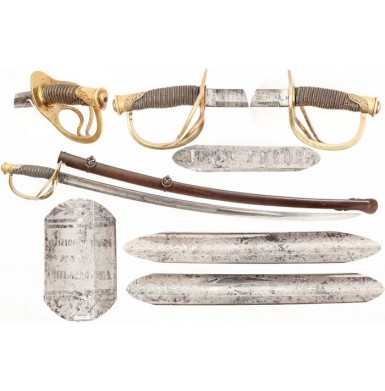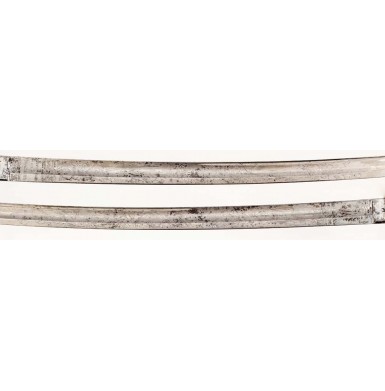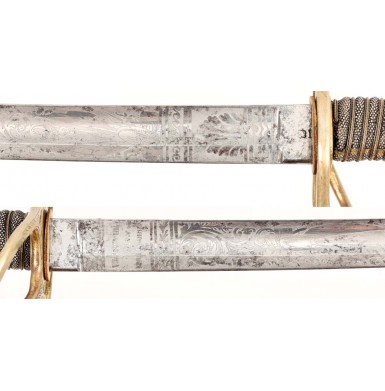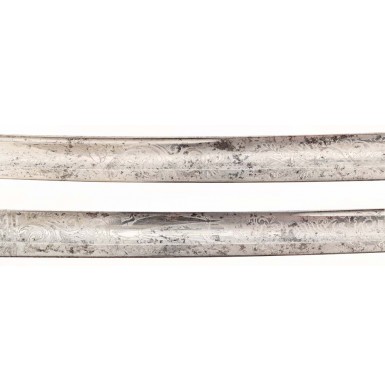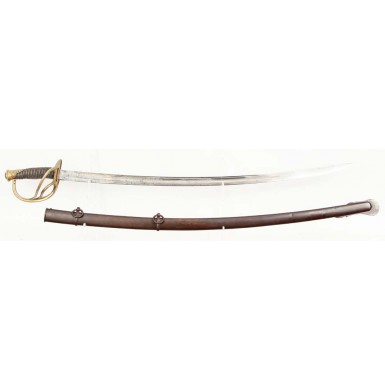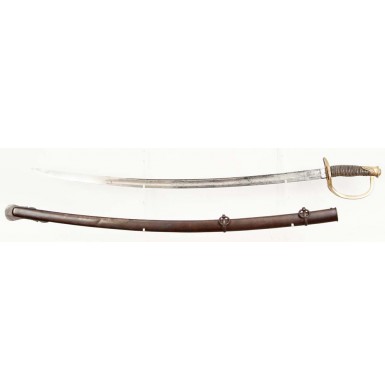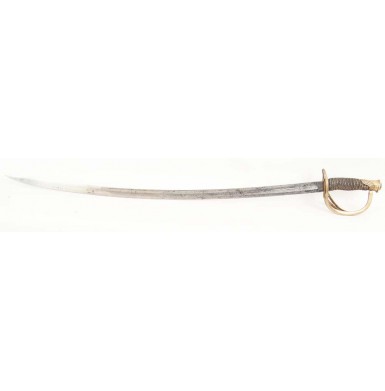This is a lovely example of a relatively scarce US M-1840 “Short Blade” Cavalry Officer’s Saber by the famous Philadelphia military goods dealer W.H. Horstmann & Sons. William H Horstmann established his military goods company in Philadelphia sometime in the mid-1820s, after immigrating to the United States from the German Confederation of States in 1816. According to work done by sword collector, researcher and author John H Thillmann, Horstmann’s first sabers offered for sale were imported from Hamburg in 1827. In his very detailed and well researched work Civil War Cavalry & Artillery Sabers, Thillmann lists Horstmann’s company as a sword “assembler” and not a manufacturer. It appears that Horstmann relied upon blades provided by other makers, sometimes even complete swords, and would assemble the swords in house, using a combination of guards, hilts and mounts of his own manufacture as well as sword parts obtained from outside sources. Horstmann also used scabbards of foreign manufacture as well as scabbards that he made himself. Even his etched blade officer’s swords appear to be a combination of blades that were purchased and etched in Philadelphia (either in house or by contract work), and those that were etched by the blade makers in Solingen, which was his primary source for blades. During the years leading up to the Civil War, Horstmann offered a wide variety of US regulation patterns swords for sale, as well as all the usual uniforms, accouterments and accessories necessary for any military man. Horstmann offered these items not only to US military officers, who had to provide their own uniforms and equipment, but also to various state and local militia units who were not equipped by the US government. With the coming of the American Civil War, Horstmann obtained his first large swords contracts, and by the end of the war would deliver some 25,188 sabers to the US Government. The large majority of these were assembled with Solingen made blades, and some were probably manufactured in their entirety in Solingen. Horstmann even obtained at least 5,000 blades from Emerson & Silver of New Jersey, which prompted Emerson to complain that it was unfair that a “sword assembler” could get a contract to provide sabers to the government, but that Emerson & Silver could not, even though they produced their own complete sabers! Horstmann produced officer’s pattern sabers during the Civil War as well, based upon both the M-1840 Heavy Cavalry Saber and the M-1860 Light Cavalry saber. Mr. Thillmann identifies at least 3 primary variations of the M-1840 Cavalry Officer’s Saber and 2 of the M-1860 Cavalry Officer’s Saber that were produced in what he call “field grade”. These were officer’s sabers that were embellished and more decorative versions of the enlisted sabers, but were still real fighting weapons without excessive ornamentation and not of “presentation grade”. Horstmann’s “field grade” M-1840 officer’s sabers were divided between three basic versions, a “long blade” (about 35 “) saber and two “short blade” (about 31 “) sabers. The primary difference between the “short blade” sabers was the presence or lack of etching. Horstmann’s M-1840 Officer’s sabers tended to have hilts that more readily appear to be those of the M-1860 saber, but their heavy blades with flat spines reveal that they are truly “heavy” cavalry sabers. These swords are almost certainly examples that were assembled by Horstmann, as the quality of the blades and etching, as well as the grip and pommel cap are usually much higher than the quality of the guard. This suggests the use of multiple contractors as the source of parts, and may indicate that the guards were something the company was making in-house.
This Horstmann US M-1840 “Short Blade” Cavalry Officer’s Saber is in about FINE to VERY FINE overall condition. The “short” heavy cavalry officer’s blade is 31 ““ in length, with a wide fuller that is about 23” long and a narrow, short fuller near the spine that is about 13” long. The stopped blade was made by Weyersburg of Solingen, Prussia, and the bottom portion of the their “King’s Head” logo is visible on the reverse ricasso. The logo appears to have been poorly struck, as only the bottom half of the stamp is clear, with the mark becoming weaker towards the upper half, and the very top never appearing to have struck the metal at all. The blade is etched with two high quality panels that are about 16” long. The bottom of the obverse panel, just above the ricasso reads in three lines: WH HORSTMANN / & SONS / PHILADELPHIA. The etched panels depict panoplies of arms and flags, mixed with floral scrolls, drums and canons. Interestingly, the etched motifs do not have a “US”, “Eagle” or “E Pluribus Unum” included anywhere on the blade. This is somewhat unique to Horstmann officer’s sabers and suggests the etched decorations were generic panels in the Weyersburg factory, which would be equally appropriate to sword blades being delivered to England, Europe or America. The spine of the blade is for about 14” with a leaf pattern, which terminates in the words JRON PROOF just forward of the hilt. The “J” being an archaic form of the letter “I”, which was still in use in some parts of the world in the mid-19th century. The blade retains most of its original bright polish and the frosted etching is about 93%+ crisp, clear and visible. The etching itself is quite bright, and not dull as it is often is on 150+ year-old sword blades, and this makes it quite difficult to photograph due to reflections of light and the surrounding environment. The blade also retains the large majority of its original high polish and is quite bright and reflective as well. The blade shows some lightly scattered oxidized surface freckling and minor discoloration that appears darker and more prevalent in the photographs than when the sword is viewed in person. These age freckles are present on both the polished surface of the blade and scattered through the etched panels as well. Most of this is actually quite light and very small, with only a couple of patches that are slightly larger, about the size of a pinkie nail. The edge is free of any noticeable nicks or chips, and the blade appears to be unsharpened. The hilt is quite attractive and combines the usual Phrygian helmet pommel cap with a decorated three-branch guard. The pommel cap is very high quality and is decorated with laurel leaves, cast into the cap. The tang peen at the rear of the pommel cap is perfect and undisturbed, indicating that this saber has never been taken apart since the day it was made. The quality of the pommel cap is top notch and is generally believed to be the work of a contractor or importer and not the Horstmann factory. This is further suggested by the much more rudimentary casting and finishing work exhibited on the guard. The guard is somewhat smaller and lighter than typically associated with M-1840 sabers, and is more reminiscent of the M-1860 saber guard. The three branches show only the most basic filing and finishing, and some of the casting roughness is visible along the interior rim on the outside edge of the guard, with some small casting flaws even visible in the branches. The two outer branches have simple leaf patterns cast into them, for about an inch, at the guard to branch juncture, and the patterns appear on both the front and the rear of the branches. The decorative casting is simple and unrefined, and shows lack of detail and sharpness along the edges of the design. This lower quality work is typical of the guards found on Horstmann 1840 Cavalry Officer Sabers. The disparity in quality between the expertly polished and etched Weyersburg blade, the crisply executed pommel cap and the mid-grade guard all point to sabers being assembled by Horstmann from components of various origins. The guard retains traces of its original gold gilt finish in the protected recesses on the interior of the guard where the branches come together. The balance of the brass has a lovely, untouched and uncleaned golden-brown patina that is very attractive. The grip is in fantastic condition and retains 95%+ of its original sharkskin wrap and all of its original wire. The grip is about 5” in length (from the rear of the guard to the rim of the pommel cap), and has a rudimentary grip swell, resembling the shape of an M-1860 grip more than an M-1840. The wire consists of a twisted central wire (much like that found the M-1833 Dragoon saber), flanked by two thin strands of gilt copper wire. Fifteen wraps of the wire are visible from the guard to the bottom rear of the pommel cap. All of the wire is original and in fine, tight condition. The original white buff leather throat washer is also in place at the guard to blade juncture and is in fine condition as well. The hilt and blade are securely joined without the least perceptible wobble or shake. The sword is contained in its original Solingen imported plain steel scabbard. These simple, unadorned, steel scabbards are typical of Horstmann “field grade” officer’s sabers, but are more often associated with the short blade sabers without etching. Clearly the officer who purchased this saber spent a little more on the sword blade, but opted for the cheaper scabbard for field use. The distinctive, Germanic, sculptured drag is the key identifying feature for these scabbards. The scabbard is in about FINE condition and has a very pleasing, untouched smooth brown patina over most of its surfaces. The metal of the scabbard was originally plain polished steel, and this attractive chocolate patina has developed over the last 150+ years. The metal is mostly smooth, with only some lightly scattered pinpricking present, along with a few small patches of lightly oxidized surface roughness. The original steel throat is in place, and is secured by its original single screw. Both original 1 3/16” diameter iron suspension rings are in place on the scabbard as well. The scabbard does show a small number of minor dings and dents, but nothing substantial, and shows no abuse or damage beyond normal service wear and tear. The saber fits the scabbard perfectly and compliments the sword nicely.
Overall this is a really attractive, 100% complete and original example of a fairly scarce WH Horstmann & Sons “Short Blade” M-1840 Cavalry Officer’s Saber. The blade etching is very high quality and nearly 100% present and complete, and the blade remains much of its original bight polish. The flecks of minor surface oxidation and age staining shown in the photos are not nearly as obvious as the pictures make them look, and the saber is really much more attractive in person than the photos lead you to believe. This would be a wonderful addition to any Civil War saber collection or a display of cavalry officer items. I have seen these sabers priced well above $2,500 recently, but his one is much more reasonably priced and will be a wonderful addition to your collection of Civil War arms.
SOLD
